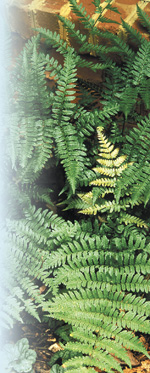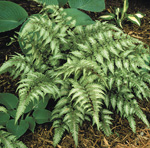Not-So-Delicate Ferns Add Versatility and Texture
go.ncsu.edu/readext?236068
en Español / em Português
El inglés es el idioma de control de esta página. En la medida en que haya algún conflicto entre la traducción al inglés y la traducción, el inglés prevalece.
Al hacer clic en el enlace de traducción se activa un servicio de traducción gratuito para convertir la página al español. Al igual que con cualquier traducción por Internet, la conversión no es sensible al contexto y puede que no traduzca el texto en su significado original. NC State Extension no garantiza la exactitud del texto traducido. Por favor, tenga en cuenta que algunas aplicaciones y/o servicios pueden no funcionar como se espera cuando se traducen.
Português
Inglês é o idioma de controle desta página. Na medida que haja algum conflito entre o texto original em Inglês e a tradução, o Inglês prevalece.
Ao clicar no link de tradução, um serviço gratuito de tradução será ativado para converter a página para o Português. Como em qualquer tradução pela internet, a conversão não é sensivel ao contexto e pode não ocorrer a tradução para o significado orginal. O serviço de Extensão da Carolina do Norte (NC State Extension) não garante a exatidão do texto traduzido. Por favor, observe que algumas funções ou serviços podem não funcionar como esperado após a tradução.
English
English is the controlling language of this page. To the extent there is any conflict between the English text and the translation, English controls.
Clicking on the translation link activates a free translation service to convert the page to Spanish. As with any Internet translation, the conversion is not context-sensitive and may not translate the text to its original meaning. NC State Extension does not guarantee the accuracy of the translated text. Please note that some applications and/or services may not function as expected when translated.
Collapse ▲
Autumn Fern
Photo by Robert E. Lyons
Ferns are one of the most popular and versatile groups of plants. Though many of us may think of the fussy little plants in the plant section at grocery stores or the ones used in hanging baskets, the hardy ferns are quite different. They are as dependable as any perennial.
North Carolina is home to many varieties of hardy ferns. Although they may look delicate and hard to grow, once they become established in the right spot they grow with very little care or maintenance. Most ferns prefer filtered sunlight, though many can tolerate dense shade or direct sun. Keep the soil evenly moist, but not soggy, and rich in organic material– similar to a natural forest habitat.
Hardy ferns come in a large range of colors and textures. They are a good solution when you want to soften the lines of hedges and fences. They provide wonderful backdrops for other plants and can add texture and color underneath existing foundation plantings. Whether in mass plantings or combined with hostas, astilbes and other shade-loving perennials, they make an interesting addition to any North Carolina garden. Most hardy ferns prefer a slightly acidic soil with a pH of 5.5 to 6.5.

Japanese Silver Painted Fern
Photo by Robert E. Lyons
One of the finest of the hardy ferns is the Christmas fern, Polystichum acrostichoides, an evergreen fern that grows in zones 3 to 9. The hay-scented fern, Dennstaedtia punctilobula, does well in zones 3 to 7 and is drought tolerant. It will even withstand salt spray. When its fronds are crushed they emit a smell similar to freshly mown hay.
Find these plants in local garden centers and from numerous catalog sources. Be sure to check your site conditions to ensure the best plant for that location before making a purchase.
To learn more, visit the JC Raulston Arboretum (JCRA) at NC State University. Sheer variety defines the JCRA’s fern collections and pure texture typifies their impact in the garden. Meander through the Lath House for some great new ideas!


